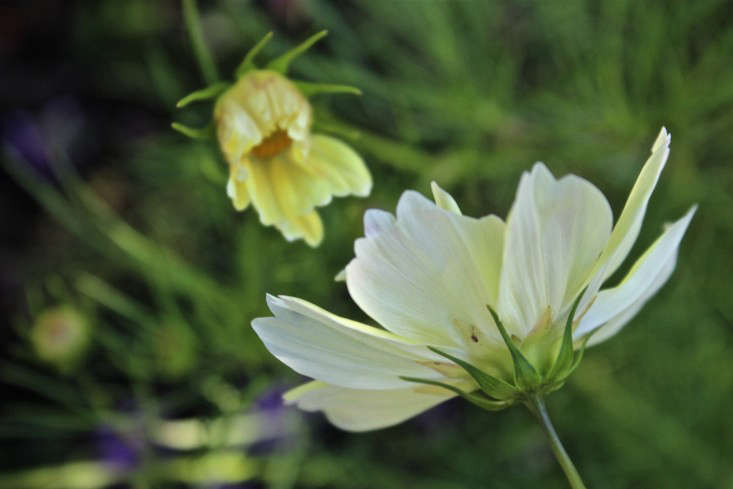Cosmos, Cosmos bipinnatus: “Mexican Aster”
With their perfectly ordered petals arranged around golden centers, cosmos flowers look a bit like planets radiating around the sun. It’s easy to see why Spanish priests, who grew these flowers in their mission gardens, named them after the Greek word kosmos, meaning order, ornament, and world.
Above: Cosmos have familiar daisy-like centers, but beyond that they’re anything but ordinary. While some do have traditional petals, others have petals that are frilled, tubular, double, and ruffled. Once the plants get going, they’ll bloom their heads off from summer until frost, so they’re perfect cutting flowers. Depending on variety, the plants can reach heights of 8 feet and diameters of 2½ feet (though many popular varieties top out at 4 feet).
Above: Cosmos ‘Sonata White’ makes an excellent container plant. Photograph via Sarah Raven.
They’re gorgeous in mixed borders, to fill empty spots, and in veggie gardens where they’ll attract bees to help pollinate your edibles.
Cheat Sheet
- Cosmos comes in shades of white, red, pink, violet, peach, orange, and yellow
- It’s a versatile annual that will fill late summer holes in flower borders
- Lacy foliage makes it a good companion to dahlias, nasturtiums, and low-growing ornamental grasses
- Will remain unwilted in a hot, sunny border if you keep it watered
Above: Photograph by Michelle Slatalla. For more, see Gardening 101: How to Deadhead Flowers.
Keep It Alive
- An annual that self-sows freely, cosmos also attracts pollinators
- Deadhead it regularly to keep it blooming, but leave a few spent flowers to allow it to self-sow
- Suitable for all US growing zones
Above: Because cosmos grows so easily from seed, it’s a popular component of many guerrilla gardeners’ Seed Bomb Mixes. Photograph by Kendra Wilson.
Sow seeds indoors, four to six weeks before your last frost date in spring, or directly in a sunny garden spot after danger of frost has passed. Since the plants can be top-heavy when they start to bloom, it’s best to grow them in groups–a little closer together than the often-recommended 2 feet apart–so they can support each other. While they want regular water early on, they’ll survive on much less as they mature. Deadhead flowers to help keep blooms coming, but leave a few spent blooms so that the plants can self-sow.
Above: These natives of Mexico get along just fine with very little care. They’re easy to grow from seed, actually prefer poor soil, and need nothing more than regular deadheading to keep looking good. Photograph by Kendra Wilson.
Read More:
Above: Photograph by Jim Powell for Gardenista. For more of this garden, see In the Garden with Philippa: Brit Style with a Black Backdrop.
For more easy-to-grow cutting flowers, see our Wildflowers and Wedding Flowers archives. Want to grow your own? See 10 Tips for Growing Cutting Flowers from Barberry Hill Farm.
Finally, get more ideas on how to successfully plant, grow, and care for cosmos with our Cosmos: A Field Guide.
Interested in other annuals for your garden? Get more ideas on how to plant, grow, and care for various annuals with our Annuals: A Field Guide.

















Have a Question or Comment About This Post?
Join the conversation (0)